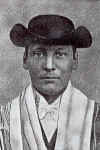


 | |
 |
Chanuka
 | See also the Lighting
page. |
 | The chanukia is light during "hanerot halalu", such that the
lighting finishes together with the singing. Thus, the first days one should
light slowly, the last days one should sing slowly.
As the
shamash cannot be detached from the chanukia,
this is done with a candle. The shamash itself is lit after "hanerot
halalu". |
 | Shacharit for
Chanuka. |
 | Arvit for Chanuka: see Arvit
page and arvit table |
 | The chanukia is also burning during shacharit. |
 | The chanukia hangs on the doors in the south wall of the Snoge, or on
the seperation fence of the
small Snoge (picture 1
and picture 2) |
 | Lighting of the
Chanukia
|
|
 Chazzan
Simon van (son of) David Duque was named to his post after a heated
election in 1923. He had a beautiful, forceful and musical voice which perfectly
fitted the large esnoga. He was born in Amsterdam on 14 March 1897 and died
in Dachau, Germany, on 19 January 1945. Chazzan
Simon van (son of) David Duque was named to his post after a heated
election in 1923. He had a beautiful, forceful and musical voice which perfectly
fitted the large esnoga. He was born in Amsterdam on 14 March 1897 and died
in Dachau, Germany, on 19 January 1945.
More on Chazzan Duque can be found elsewhere
on this site.
 |
15 Shevat
 | The night of 15 Shevat we have the minhag to organize a Limud. |
|
 |
 | On Shabbat Zachor (Shabbat before Purim) we sing Mi
Chamocha (מי כמוך) on page 174 in
the green tefillot. |
 | We have evidence in the ceremonies
book from about 1810 (page 11, Purim) and an article
from 1925, both Dutch, that "machatsit hashekel" was
automatically added to the fintas (bi-annual membership) which was paid
around Rosh Chodesh Nissan. This mitswa (obligation) thus was kind of
hidden from the members. Somewhere it got lost (we now pay membership in
January). The common statement that "We do not have the minhag of "machatsit hashekel"
is thus incorrect. Now that it isn't done centrally, the obligation
returns to the individual. An article
on this (in Dutch).

Tassa, to be used for collecting "machatsit hashekel", picture: DCP.
Mind that three tassas are used on each Public Fast for collection
during Mincha. |
 | It is our custom to start reading the Megillah some 20 minutes before tzeit hakochavim, so that the chazzan reads the first words of chapter 6 (בלילה
ההוא) at nightfall. The reason is probably to avoid
lengthening the fast more then necessary (*). Of course, this is not the the
case when the Megillah is read on motzei Shabbat. |
 | Mincha
ta'anit Esther |
 | Arvit
for Purim |
 | Shacharit
for Purim |
 | Megillat Esther (Complete recording,
9.4MB), berachot before the
reading, and after the
reading. |
 | Megillat Esther, live recording in the Esnoga on Purim 5781-202 audio
recording (full) and Video clip. |
 | Megilat
Esther, full recording ARP |
 | Some verses are sung by the congregation first, see end
of page. |
 | It is our custom not to make any noises when reading the name "Haman". |
 | Songs for Purim: song
1, song
2 |
(*) See בית
יוסף או"ח
תרפ"ז:
"... נהגו
לקרותה
מבעוד יום
ליל ארבעה
עשר כדי להקל
על האנושים
והמעוברות
שלא להתענות
יותר מדאי" |
 |
5 Iyar (Yom ha'Atzmaut) and 28 Iyar (Yom Yerushalyim)
 | Techinot are omitted. |
 | Full Halel is recited with beracha, see annotated version Seder hazzanut
page 180:
 |
 | Yom ha'Atzmaut (יום
העצמאות) is celebrated on
Shabbat following 5 Iyar. Hanoteen (page 69) and both mi sheberachs (page 226-227) are read as usual, but leaving out the words
מדינת ישראל
ויגדיל שם
התורה
ויאדירה וגם and skipping מי
שברך לחיילי
צה"ל.
Once the Sefer Torah is brought back to the Hechal, the Parnaas opens the hechal and returns to his place. Psalms 117 & 118 (pages 157-158) are sung without repetition. The Chazzan reads
אבינו שבשמים (text taken from last page
Kippur prayer
book), followed by מי שברך לחייל צה"ל (page 233). Finally psalm 67 (page 101) is sung. The Parnaas closes the hechal, returns to his place and the service is continued as usual. |
|
|